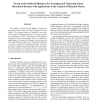Free Online Productivity Tools
i2Speak
i2Symbol
i2OCR
iTex2Img
iWeb2Print
iWeb2Shot
i2Type
iPdf2Split
iPdf2Merge
i2Bopomofo
i2Arabic
i2Style
i2Image
i2PDF
iLatex2Rtf
Sci2ools
CVPR
2012
IEEE
2012
IEEE
Group action induced distances for averaging and clustering Linear Dynamical Systems with applications to the analysis of dynami
We introduce a framework for defining a distance on the (non-Euclidean) space of Linear Dynamical Systems (LDSs). The proposed distance is induced by the action of the group of orthogonal matrices on the space of statespace realizations of LDSs. This distance can be efficiently computed for large-scale problems, hence it is suitable for applications in the analysis of dynamic visual scenes and other high dimensional time series. Based on this distance we devise a simple LDS averaging algorithm, which can be used for classification and clustering of time-series data. We test the validity as well as the performance of our groupaction based distance on synthetic as well as real data and provide comparison with state-of-the-art methods.
| Added | 28 Sep 2012 |
| Updated | 28 Sep 2012 |
| Type | Journal |
| Year | 2012 |
| Where | CVPR |
| Authors | Bijan Afsari, Rizwan Chaudhry, Avinash Ravichandran, René Vidal |
Comments (0)

